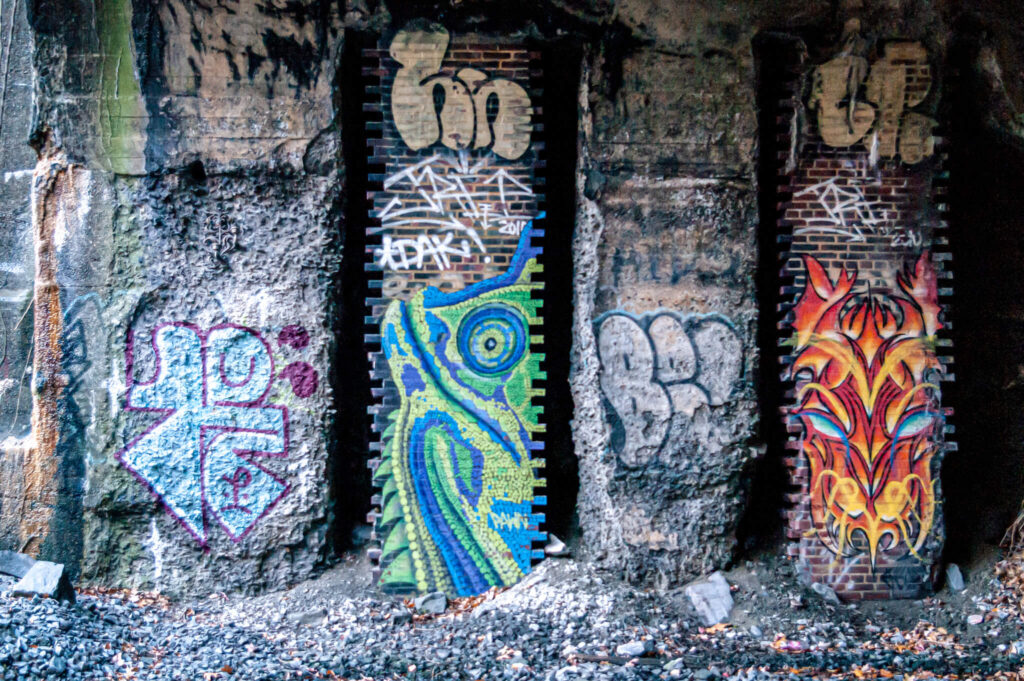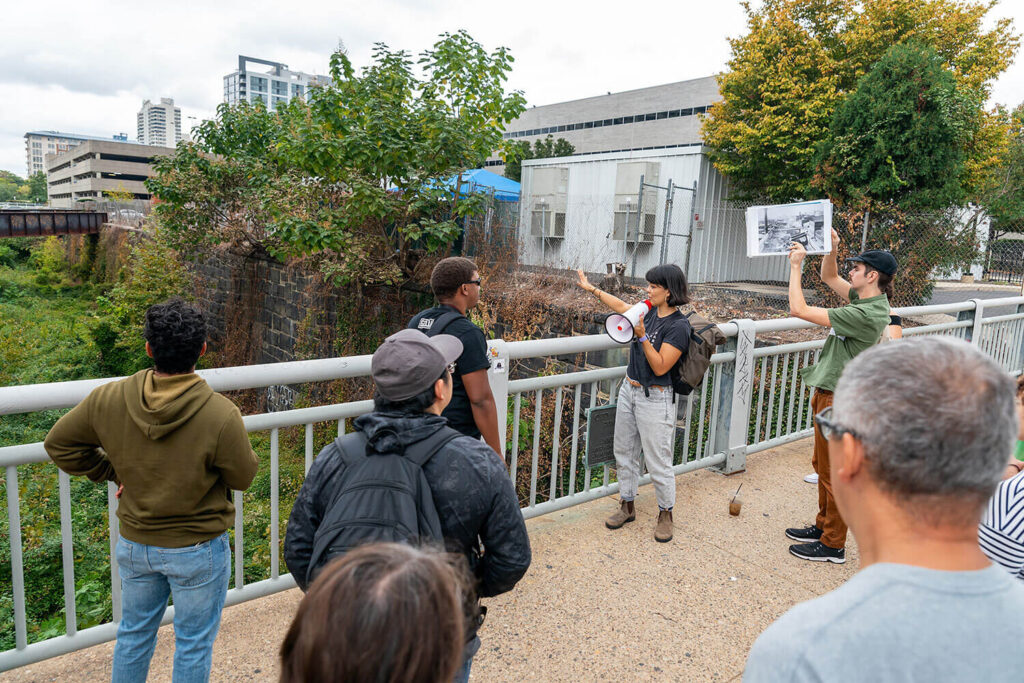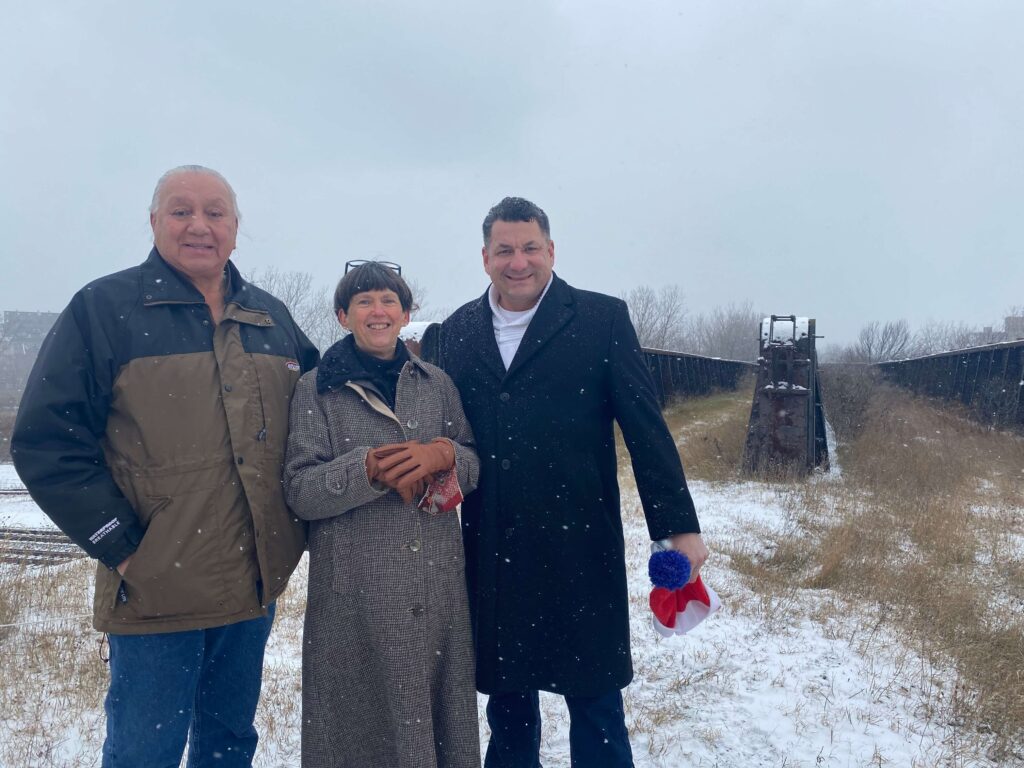Would you like to showcase your own work to embed equity in your infrastructure reuse project?
Connecting History, Place, and Street Art

A view of the Bergen Arches area. Credit: Bergen Arches Preservation Coalition.
Bergen Arches is the common name for the Erie Railroad’s mile-long, under-utilized railroad trench that once served four passenger rails in Jersey City, NJ. Bergen Arches Preservation Coalition (BAPC), the community group advocating for its conservation and transformation, aims to create legal access to the Arches by establishing a shared-use nature path as part of the East Coast Greenway—a national trail that runs from Maine to Florida.
The main mission of BAPC is to promote education on the benefits of preserving the existing ecology and historical structure of the site, and the potential of an infrastructure re-use project within a dense urban environment like Jersey City. BAPC has been successful honing in on community engagement strategies centered in history, culture and art, weaving these elements and using visual imagery and storytelling of the history of the Arches.
They have been doing so by placing the railroad’s history front and center through images of how the railroad was once used as a transit corridor. This required extensive research work compiling historic records from the Jersey City Public Library’s New Jersey Room archives. Given the limited documentation of the history of the space, BAPC also explored art and railroad galleries in the region to piece the story of the Arches together.
This effort helped the community surrounding the Arches gain a better understanding of the value of the open space, appreciating it beyond its current state. The space is now seen as a future greenway, connecting its potential as a green space with uplifting its past as a transit corridor to unify dispersed transport infrastructure. The space also can address larger issues of accessibility, circulation, and social equity throughout the region.
BAPC also channeled community engagement efforts through a visual feature that was already present: graffiti art. The wealth of the graffiti art in the Arches was first explored by one of BAPC’s oldest board members Bill Benzon. Benzon realized the tremendous diversity of graffiti that existed within and beyond the Arches. As Benzon documented the changing nature of the graffiti art, he realized the Arches were home to a large community of graffiti artists from around the world. This exploration led to more interesting findings about how graffiti artists used the Arches, including artistic exchanges and unspoken communication. This has opened up a whole different dimension to the use of the Arches as a secret gallery for artists from all over the world.
The use of art and images has helped BAPC elevate the Arches’ relevance to its urban community as a critical opportunity for transportation connectivity in the area.
Project Org
Bergen Arches Preservation CoalitionRelated Toolkit Section
Examine HistoryRelated Tool
MAP COMMUNITY ASSETSBergen Arches is the common name for the Erie Railroad’s mile-long, under-utilized railroad trench that once served four passenger rails in Jersey City, NJ. Bergen Arches Preservation Coalition (BAPC), the community group advocating for its conservation and transformation, aims to create legal access to the Arches by establishing a shared-use nature path as part of the East Coast Greenway—a national trail that runs from Maine to Florida.
The main mission of BAPC is to promote education on the benefits of preserving the existing ecology and historical structure of the site, and the potential of an infrastructure re-use project within a dense urban environment like Jersey City. BAPC has been successful honing in on community engagement strategies centered in history, culture and art, weaving these elements and using visual imagery and storytelling of the history of the Arches.
They have been doing so by placing the railroad’s history front and center through images of how the railroad was once used as a transit corridor. This required extensive research work compiling historic records from the Jersey City Public Library’s New Jersey Room archives. Given the limited documentation of the history of the space, BAPC also explored art and railroad galleries in the region to piece the story of the Arches together.
This effort helped the community surrounding the Arches gain a better understanding of the value of the open space, appreciating it beyond its current state. The space is now seen as a future greenway, connecting its potential as a green space with uplifting its past as a transit corridor to unify dispersed transport infrastructure. The space also can address larger issues of accessibility, circulation, and social equity throughout the region.
BAPC also channeled community engagement efforts through a visual feature that was already present: graffiti art. The wealth of the graffiti art in the Arches was first explored by one of BAPC’s oldest board members Bill Benzon. Benzon realized the tremendous diversity of graffiti that existed within and beyond the Arches. As Benzon documented the changing nature of the graffiti art, he realized the Arches were home to a large community of graffiti artists from around the world. This exploration led to more interesting findings about how graffiti artists used the Arches, including artistic exchanges and unspoken communication. This has opened up a whole different dimension to the use of the Arches as a secret gallery for artists from all over the world.
The use of art and images has helped BAPC elevate the Arches’ relevance to its urban community as a critical opportunity for transportation connectivity in the area.
Share this Case Study


